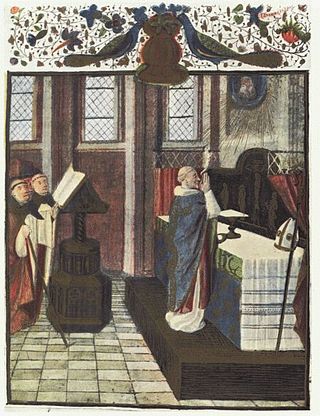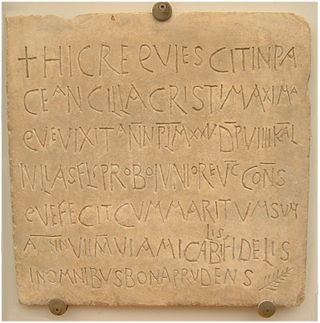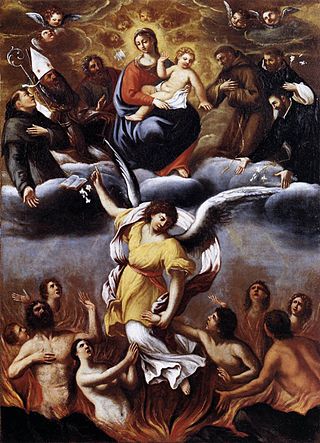
All Souls' Day, also called The Commemoration of All the Faithful Departed, is a day of prayer and remembrance for the faithful departed, observed by Christians on 2 November. In Western Christianity, including Roman Catholicism and certain parts of Lutheranism and Anglicanism, All Souls' Day is the third day of Allhallowtide, after All Saints' Day and All Hallows' Eve. Before the standardization of Western Christian observance on 2 November by St. Odilo of Cluny in the 10th century, many Roman Catholic congregations celebrated All Souls' Day on various dates during the Easter season as it is still observed in the Eastern Orthodox Church, the Eastern Catholic churches and the Eastern Lutheran churches. Churches of the East Syriac Rite commemorate all the faithful departed on the Friday before Lent. As with other days of the Allhallowtide season, popular practices for All Souls Day include attending Mass offered for the souls of the faithful departed, as well as Christian families visiting graveyards in order to pray and decorate their family graves with garlands, flowers, candles and incense. Given that many Christian cemeteries are interdenominational in nature, All Souls Day observances often have an ecumenical dimension, with believers from various Christian denominations praying together and cooperating to adorn graves.

Christianity is an Abrahamic monotheistic religion, professing that Jesus Christ was raised from the dead and is the Son of God, whose coming as the Messiah was prophesied in the Hebrew Bible and chronicled in the New Testament. It is the world's largest and most widespread religion with over 2.38 billion followers, comprising around 31.2% of the world population. Its adherents, known as Christians, are estimated to make up a majority of the population in 157 countries and territories.
RIP is a common element of Christian epitaphs.

Mass is the main Eucharistic liturgical service in many forms of Western Christianity. The term Mass is commonly used in the Catholic Church, Western Rite Orthodoxy, Old Catholicism, and Independent Catholicism. The term is also used in many Lutheran churches, as well as in some Anglican churches, and on rare occasion by other Protestant churches.

The Advent wreath, or Advent crown, is a Christian tradition that symbolizes the passage of the four weeks of Advent in the liturgical calendar of the Western church. It is traditionally a Lutheran practice, although it has spread to many other Christian denominations.

Hallelujah is an interjection from the Hebrew language, used as an expression of gratitude to God. The term is used 24 times in the Tanakh, twice in deuterocanonical books, and four times in the Christian Book of Revelation.
Religions with the belief in a final judgment, a resurrection of the dead or an intermediate state often offer prayers on behalf of the dead to God.

The communion of saints, when referred to persons, is the spiritual union of the members of the Christian Church, living and the dead, but excluding the damned. They are all part of a single "mystical body", with Christ as the head, in which each member contributes to the good of all and shares in the welfare of all.

Compline, also known as Complin, Night Prayer, or the Prayers at the End of the Day, is the final prayer liturgy of the day in the Christian tradition of canonical hours, which are prayed at fixed prayer times.

Eternal Rest or Requiem aeternam is a Western Christian prayer asking God:
Christian liturgy is a pattern for worship used by a Christian congregation or denomination on a regular basis. The term liturgy comes from Greek and means "public work". Within Christianity, liturgies descending from the same region, denomination, or culture are described as ritual families.

In Christianity, worship is the act of attributing reverent honour and homage to God. In the New Testament, various words are used to refer to the term worship. One is proskuneo which means to bow down to God or kings.

In Christian liturgy, "the Pax" is an abbreviation of the Latin salutations "pax vobis" or "pax vobiscum", which are used in the Catholic Mass, the Lutheran Divine Service, and the Western Orthodox Mass.

Orans, a loanword from Medieval Latin orans translated as "one who is praying or pleading", also orant or orante, as well as lifting up holy hands, is a posture or bodily attitude of prayer, usually standing, with the elbows close to the sides of the body and with the hands outstretched sideways, palms up. The orans posture of prayer has a Scriptural basis in 1 Timothy 2 : "I desire, then, that in every place the men should pray, lifting up holy hands without anger or argument" (NRSV).
Dóminus vobíscum is an ancient salutation and blessing traditionally used by the clergy in the Masses of the Catholic Church and other liturgies, as well as liturgies of other Western Christian denominations, such as Lutheranism, Anglicanism and Methodism.

An emergency baptism is a baptism administered to a person in immediate danger of death. This can be a person of any age, but is often used in reference to the baptism of a newborn infant. The baptism can be performed by a person not normally authorized to administer the sacraments.

In some forms of Christianity, the intermediate state or interim state is a person's existence between death and the universal resurrection. In addition, there are beliefs in a particular judgment right after death and a general judgment or last judgment after the resurrection. It bears resemblance to the Barzakh in Islam.

Early Christian inscriptions are the epigraphical remains of early Christianity. They are a valuable source of information in addition to the writings of the Church Fathers regarding the development of Christian thought and life in the first six centuries of the religion's existence. The three main types are sepulchral inscriptions, epigraphic records, and inscriptions concerning private life.

Purgatory is a passing intermediate state after physical death for purifying or purging a soul. A common analogy is dross being removed from gold in a furnace.
Protestant liturgy or Evangelical liturgy is a pattern for worship used by a Protestant congregation or denomination on a regular basis. The term liturgy comes from Greek and means "public work". Liturgy is especially important in the Historical Protestant churches, both mainline and evangelical, while Baptist, Pentecostal, and nondenominational churches tend to be very flexible and in some cases have no liturgy at all. It often but not exclusively occurs on Sunday.



















